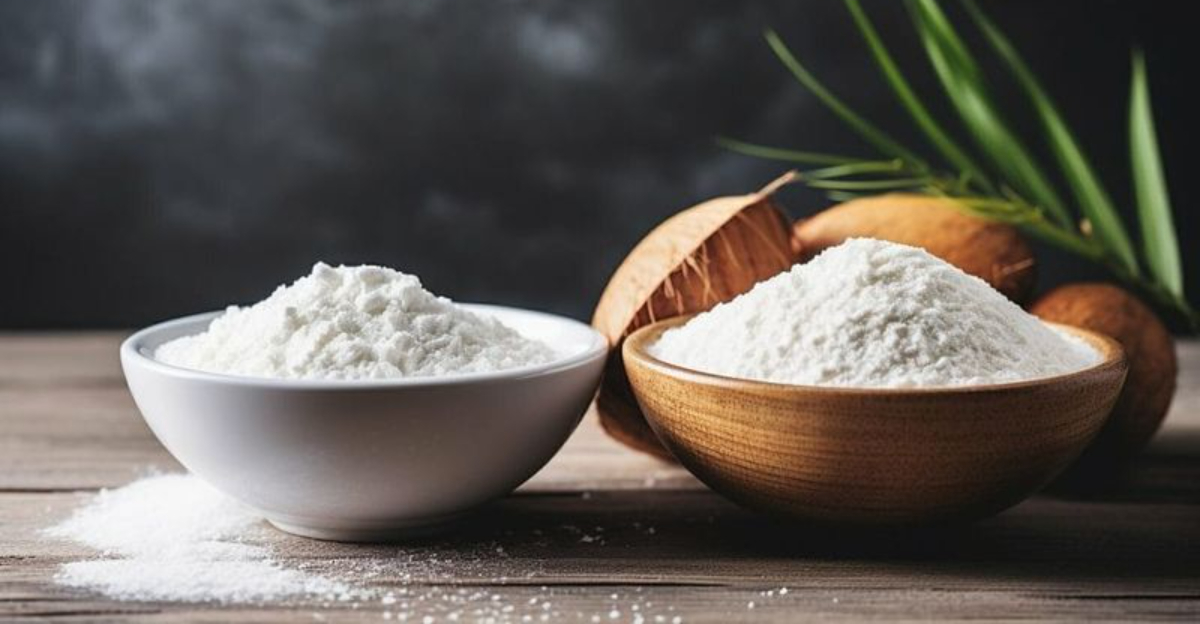4 Kinds Of Flour You Should Never Eat And 4 That Are Actually Super Healthy

I never gave much thought to flour, just another basic ingredient, until my doctor warned me about my rising blood sugar levels last year.
That wake-up call sent me to the grocery store, where I stood frozen in the baking aisle, surrounded by bags of flour I didn’t understand. It was then I realized how important this seemingly simple pantry staple really is.
Flour isn’t just a white powder, it’s the base of countless dishes and can either support your health or silently undermine it. Let me share what I’ve discovered about the flours you should avoid and the nutrient-rich options worth trying.
1. Refined White Flour: The Nutritional Ghost

Opening my grandmother’s vintage cookbook recently, I noticed almost every recipe called for white flour. No wonder! This highly processed flour has been stripped of its nutritional soul, the bran and germ, leaving behind empty calories that spike blood sugar faster than a roller coaster climb.
The processing removes fiber, vitamins, and minerals that would naturally slow digestion. Your body processes it almost like pure sugar.
I’ve stopped using it for daily cooking, saving it only for occasional treats. The difference in my energy levels has been remarkable, no more mid-afternoon crashes after sandwich lunches!
2. Bleached Flour: Chemical Cocktail in Disguise

Last summer, I baked identical muffins using bleached and unbleached flour. The bleached batch looked prettier but knowing what I know now makes me shudder. Manufacturers treat this flour with chemicals like benzoyl peroxide and chlorine to achieve that pristine white appearance.
These agents speed up the aging process and improve texture, but at what cost? Many countries have banned potassium bromate, a common bleaching agent, due to potential cancer links.
My pantry purge revealed three bags of bleached flour hiding in the back. They went straight to the trash, replaced by their unprocessed cousins that might not look as perfect but certainly treat my body better.
3. Self-Rising Flour: Salt Bomb in Waiting

Convenience almost cost me my health goals! Self-rising flour seemed like a time-saver until I read the ingredients list. Beyond being refined white flour, it packs a sodium punch from added salt and leavening agents that my blood pressure definitely doesn’t need.
My neighbor swears by it for biscuits, but I’ve discovered mixing my own healthier version using whole grain flour with aluminum-free baking powder. The flavor is actually richer!
For someone watching their sodium intake, which should be all of us, this flour variety creates an unnecessary health hurdle. One cup contains nearly 1,600mg of sodium, over half the recommended daily limit!
4. Instant Flour: The Ultra-Processed Thickener

My grandmother’s gravy always tasted better than mine, mystery solved when I discovered she never used instant flour! This ultra-processed option is pre-gelatinized to dissolve instantly without lumps, making it convenient but nutritionally bankrupt.
During a cooking class last month, the chef called it “the microwave dinner of flours”, engineered for speed, not health. Its high glycemic index means rapid blood sugar spikes that leave you hungry again quickly.
I’ve switched to arrowroot powder or whole grain options for thickening sauces. My body thanks me with steadier energy levels, and surprisingly, my gravies taste more complex and satisfying now!
5. Almond Flour: Protein-Packed Baking Champion

Saturday morning pancakes transformed when I swapped regular flour for almond flour! Made from blanched, ground almonds, this protein powerhouse contains healthy fats that keep me satisfied until lunch, no more mid-morning snack attacks.
My kids didn’t even notice the switch but commented that they felt fuller longer. Rich in vitamin E and magnesium, almond flour supports everything from skin health to muscle function.
A friend with diabetes introduced me to this game-changer, explaining how its low glycemic index prevents blood sugar rollercoasters. The subtle nutty flavor enhances chocolate chip cookies beautifully, they taste indulgent while actually supporting your health!
6. Coconut Flour: Fiber Superstar with Tropical Flair

My first coconut flour experiment was a disaster, rock-hard muffins that even the birds wouldn’t eat! I’ve since learned this fiber-rich flour absorbs liquid like a sponge, requiring recipe adjustments but offering incredible nutritional rewards.
Just quarter-cup contains a whopping 10 grams of fiber, more than twice what you’d get from whole wheat. The medium-chain triglycerides (MCTs) it contains may boost metabolism and brain function.
Now I use it for coating chicken before baking (creates an amazing crispy texture!) and in banana bread where its natural sweetness shines. My digestive system has never been happier, and friends always ask for my “secret ingredient” recipe.
7. Oat Flour: Heart-Healthy Comfort in Every Bite
Running late one morning, I blended some oats into powder for pancakes, accidentally discovering oat flour! That happy kitchen mistake introduced me to a heart-healthy game changer packed with beta-glucan fiber that actively lowers cholesterol.
Unlike some alternative flours, oat flour creates that comforting, tender texture we crave in baked goods. My cholesterol-watching husband appreciates that his favorite cookies now actually help his health.
I make my own by pulsing rolled oats in the blender until fine, much cheaper than store-bought versions! For anyone with gluten sensitivity (but not celiac disease), certified gluten-free oat flour offers familiar baking results without digestive distress.
8. Quinoa Flour: Ancient Grain for Modern Nutrition
Stumbling across quinoa flour at a farmers market changed my baking forever! This complete protein powerhouse contains all nine essential amino acids our bodies can’t produce, rare for plant foods and amazing for vegetarians like my daughter.
The nutty, slightly grassy flavor creates breads with character. My family initially wrinkled their noses but now requests my quinoa banana muffins specifically.
Ancient Incas called quinoa the “mother grain” for its life-sustaining properties. I’ve found it works beautifully in savory crackers and pizza crusts, adding a protein boost that keeps hunger at bay. For anyone looking to increase nutritional density without sacrificing taste, this flour deserves prime pantry space!
